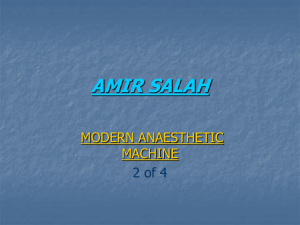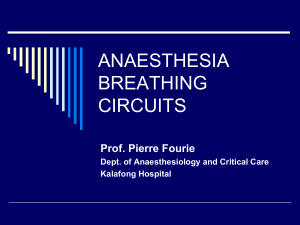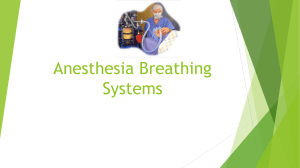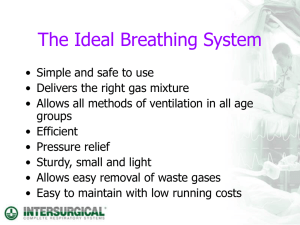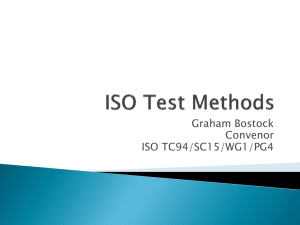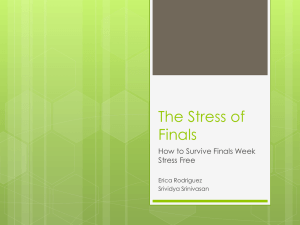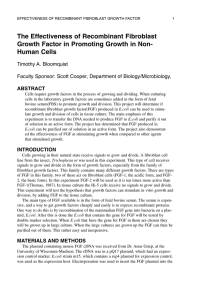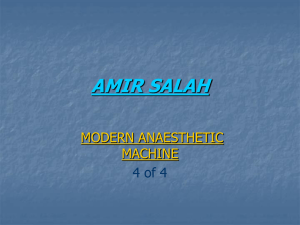Size: 6 MB - paediatric breathing systems
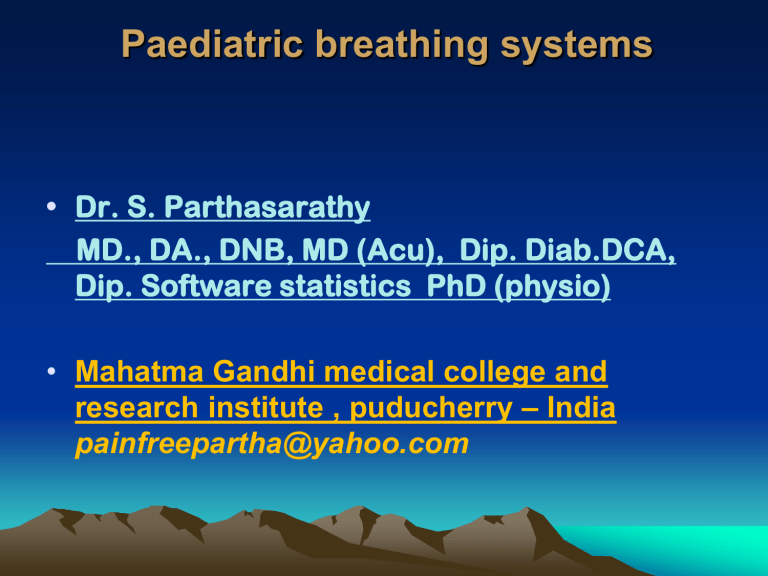
Paediatric breathing systems
• Dr. S. Parthasarathy
MD., DA., DNB, MD (Acu), Dip. Diab.DCA,
Dip. Software statistics PhD (physio)
• Mahatma Gandhi medical college and research institute , puducherry – India painfreepartha@yahoo.com
• Just after the tea session ----
• We are moving on to the
T
session
Dr Philip Ayre
Lets go back !!
• It was because Dr. Phillip Ayre lost a child due to high pressure gas flow, he came out with tubing for children to breathe safely in 1937 termed
Ayre’s T piece.
• anaesthetic breathing systems for paediatric use have undergone innumerable modifications to suit different patients and situations.
Circuit or system !!
• Such systems were also called circuits, but as the gas flow is not circuitous in many of them, the word breathing system is preferred. Most of the systems can also be used with ventilators.
• What is a breathing system?
Definition
• A breathing system is defined as an assembly of components which connects the patient’s airway to the anaesthetic machine creating an artificial atmosphere, from and into which the patient breathes.
Components
• A fresh gas entry port / delivery tube
• A reservoir for gas, in the form of a bag
• A port to connect it to the patient's airway;
• An expiratory port / valve
• Corrugated tubes for connecting these components.
Components
• A carbon dioxide absorber if total rebreathing is to be allowed
• Flow directing valves may or may not be used
SOME DEFINITIONS
.
• Breathing tubing made of either rubber or plastic are usually corrugated to enable bending without kinking
• corrugation may increase compliance important in ventilating noncompliant lungs.
• more gas rests in the tubing -- excess dead space * IMPORTANT IN PAEDIATRICS.
• tubing with smooth inner are also in the offing
• Reservoir bags (RB
- either a tube or a bag.
• monitoring respiration
• ventilating the patient
• reservoir of gas to meet patient’s inspiratory flow requirements.
• Otherwise HIGH fresh gas flows (FGF) needed.
• We should keep in mind that anaesthesia machines give continuous supply of gas and all our patients are intermittent inhalers.
• Expiratory port valve ( APL valve)
• -user adjustable valve that releases gases to atmosphere or the scavenging system. It is usually made of metal with a seat and disc against a spring.
• paediatric APL valve : less resistance,
• safer and effective scavenging-possible.
DEFINITIONS
• The afferent limb is that part of the breathing system which delivers the fresh gas from the machine to the patient.
• reservoir is placed in this limb as in
Mapleson A, B, C and Lack’s systems, afferent reservoir systems (ARS).
Definitions
• The efferent limb -part of the breathing system which carries expired gas from the patient and vents it to the atmosphere through the expiratory valve/port.
• reservoir placed in this limb as in
Mapleson D, E, F and Bain systems, efferent reservoir systems (ERS).
Apparatus dead space
• It is the volume of the breathing system from the patientend to the point up to which, to and fro movement of expired gas takes place.
• A . afferent reservoir system, the apparatus dead space extends up to the expiratory valve positioned near the patient.
• B. efferent reservoir system, the dead space extends up to the point of FG entry
• C. In systems where inspiratory and expiratory limbs are separate, it extends up to the point of bifurcation
SHORT BREAK.
• AS A GUEST SPEAKER IN GANDHI
JAYANTHI CELEBRATION IN
SCHOOL.
• I WAS ELABORATING ABOUT THE
PRINCIPLES OF NONVIOLENCE,
DANDI MARCH,QUIT INDIA
MOVEMENT KHADI DRESS ETC….
AFTER I FINISHED
• ONE FELLOW STOOD UP TO ASK
A DOUBT.
• ‘ SIR, YOU HAVE SPOKEN NICELY
ON GANDHI IN THIS GANDHI
JAYANTHI FUNCTION ---WHO IS
JAYANTHI ?
PLEASE TELL US
SOMETHING SIR’
Certain characteristics which differ in paediatric patients
• Minimal resistance : resistance is increased according to the fourth power of radius and hence a wide bore tube with diameter of not less than 1 cm is ideal.
• less dead space
Eg.3 kg infant –
Tidal volume : 21 ml (7ml/kg)
Concerns in paediatrics
• Lightness and ease of use.
• Ribs are horizontal and breathing is diaphragmatic. The infant diaphragm has mainly type 1 fibres and easily fatigued .
• Increased CO
2 production (8ml/kg in infants Vs 4 ml/kg in adults.)
• Any increase in minute ventilation is due to increase in rate than tidal volume.
T piece
• The T piece system -- light metal tube, 1 cm in diameter, and 5 cm in length with a side arm.
FGF enters the system through the side
• expired gas goes to the atmosphere.
• system is short
• diameter is more than trachea with no valves the resistance is minimal .
• The dead space is very less as it is only up to the point of entry of FGF.
• Air dilution - prevented by a FGF equivalent to peak inspiratory flow rate (PIFR).
• These factors suit its use in paediatrics.
T
AND MODIFICATIONS.
LACK AND BAINS
• So almost every thing is around
T
• The pattern of controlled ventilation
(control is with us),
• Low resp. rate
• High tidal volume
• Less inspiration time.
• Long exp. Pause.
• ------ then we need less FGF
Curve -- normocarbia
Jackson rees FGF req.
• Body weight (kg) & Fresh gas flow (L/min)
• 5 kg : 1.4 - 1.8 5 kg : 0.6
• 10 kg : 2.4 - 3.2
• 20 kg : 4.1 - 5.4
• 40 kg : 7.2 - 9.6
↑
10 kg :1.1
20 kg : 1.9
40 kg : 3.3
↑
SPONT CONTROLLED
Ventilator – 15 breaths/min
TV 10 ml/kg approx --ok
D, E and F
• In simple terms, controlled ventilation is possible with 70 ml/kg and spontaneous ventilation may need upto 250 ml/kg to maintain normocarbia.
• It should be emphasized that these values are guidelines only; if there is evidence of rebreathing (e.g. an increase in the end tidal
CO2 concentration or unexpected hyperventilation), the flow rate should be increased.
• Functional analysis of D, E and F are similar.
CIRCLE SYSTEMS
APPREHENSIONS IN PAEDIATRIC USE
• Connectors, unidirectional valves and canisters cause
• ↑ dead space
• ↑ resistance
• Is low flow possible?
introduction of low resistance valves, improved soda lime canisters and low dead space connectors--done low flow possible - studies prove
Heat and fluid conservation efficient scavenging
Inhalational agent use decrease
Unidirectional valves
• Resistance inversely proportional fourth power of radius.
• Pressure needed to lift the valve
P = W ÷ D 2 small light discs-- ok
Divided airway adapter revell circulator
Miscellaneous systems
• Humphrey ADE
• MERA F are also used in paediatrics.
SO ! WHAT IS THE CARRY HOME
MESSAGE?
Summary
• A number of systems are in vogue.
• Dead space, resistance, ↑ CO2 production, light weighted systems – points to think about.
• Controlled ventilation is most often used
• Jackson rees,
• Mapleson D and Bains
• Circle
• Jackson rees: Spont. –ok but FGF 200-
250 ml/kg Contrl. Good 70- 80 ml/kg
• Mapleson D and Bains : same as JR
• Circle: Paed. Special circle?
• Adult system with paediatric tubing ok
• Low flow anaesthesia,less agent and
FGF costs,scavenging,humidity and heat conservation – thoughts swing in favour of circles in the coming era
After all, its us we decide
• We should know the system.
• We should know that
ETT offers maximal resistance
• We should be well versed ,experienced
• A proper pre op check of the system is a must
•
When you inhale you inspire
•
But when you don’t ---
Questions for PGs
• 1. What will happen if Mapleson A is connected to a ventilator?
• 2. What will happen if bain’s circuit is connected to a ventilator?
• 3.What is the amount of gas let out thro spill valve each time? RR 15/min- tidal volume
500 FGF 4.5 l/min.
1 = Mapleson a system becomes dead space
2. It becomes mapleson E
3. Think and answer
